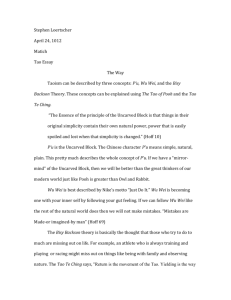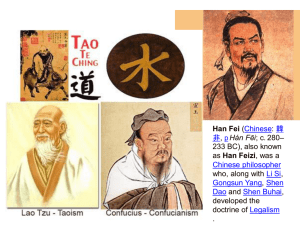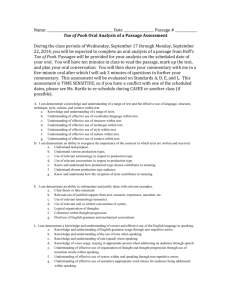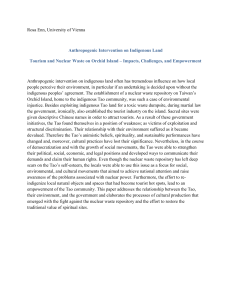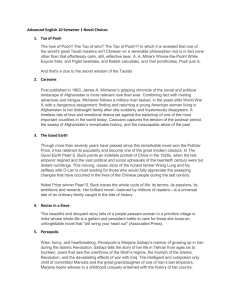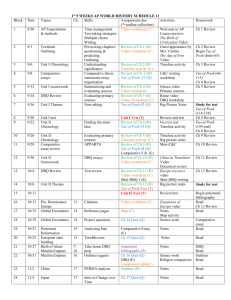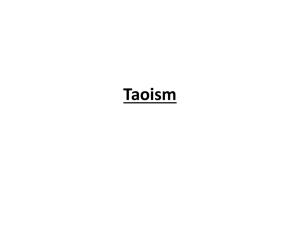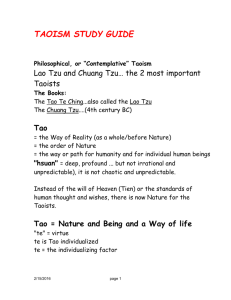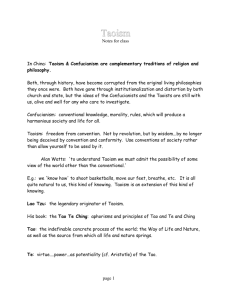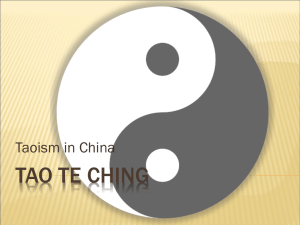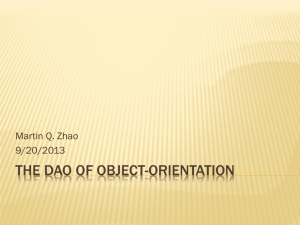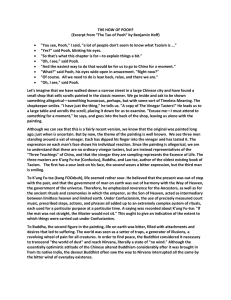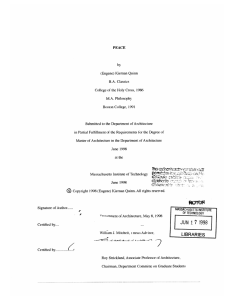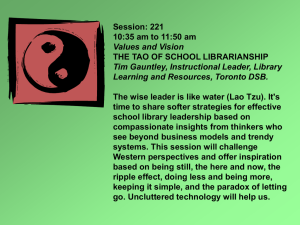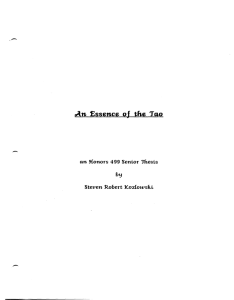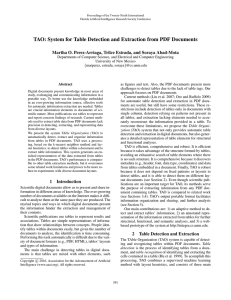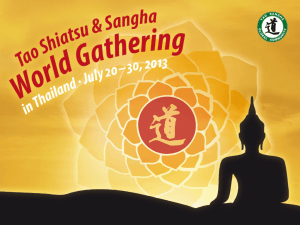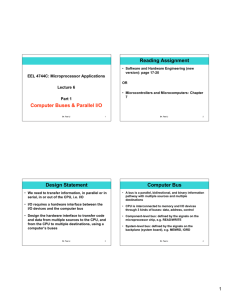The Tao of Pooh: Discussion Questions
advertisement
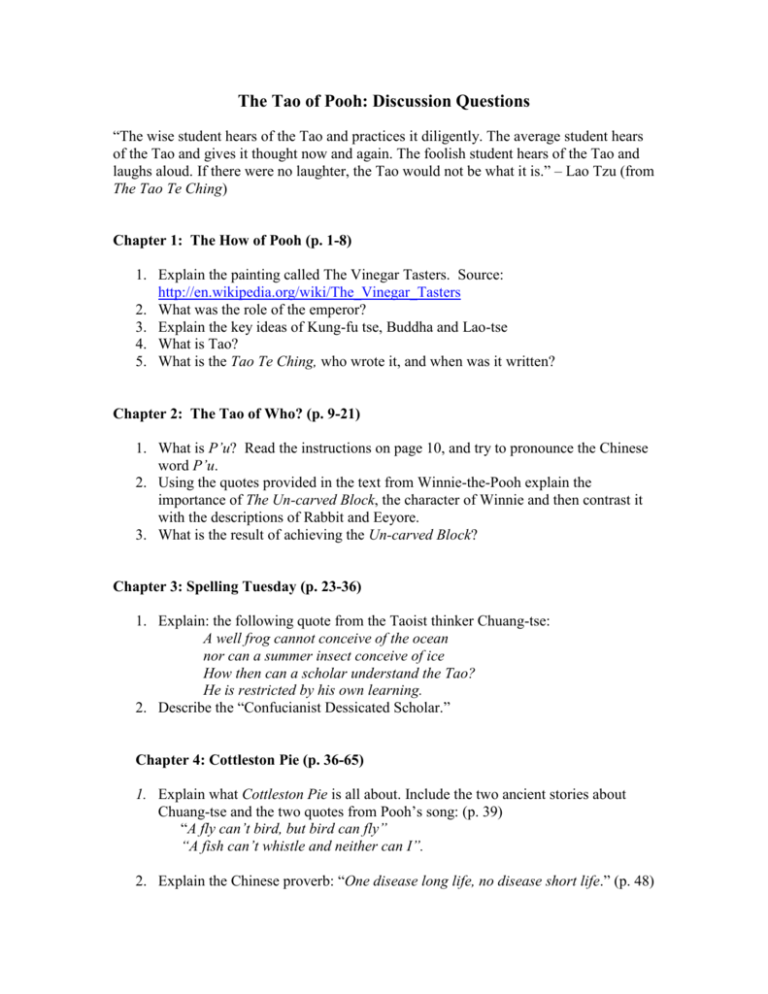
The Tao of Pooh: Discussion Questions “The wise student hears of the Tao and practices it diligently. The average student hears of the Tao and gives it thought now and again. The foolish student hears of the Tao and laughs aloud. If there were no laughter, the Tao would not be what it is.” – Lao Tzu (from The Tao Te Ching) Chapter 1: The How of Pooh (p. 1-8) 1. Explain the painting called The Vinegar Tasters. Source: http://en.wikipedia.org/wiki/The_Vinegar_Tasters 2. What was the role of the emperor? 3. Explain the key ideas of Kung-fu tse, Buddha and Lao-tse 4. What is Tao? 5. What is the Tao Te Ching, who wrote it, and when was it written? Chapter 2: The Tao of Who? (p. 9-21) 1. What is P’u? Read the instructions on page 10, and try to pronounce the Chinese word P’u. 2. Using the quotes provided in the text from Winnie-the-Pooh explain the importance of The Un-carved Block, the character of Winnie and then contrast it with the descriptions of Rabbit and Eeyore. 3. What is the result of achieving the Un-carved Block? Chapter 3: Spelling Tuesday (p. 23-36) 1. Explain: the following quote from the Taoist thinker Chuang-tse: A well frog cannot conceive of the ocean nor can a summer insect conceive of ice How then can a scholar understand the Tao? He is restricted by his own learning. 2. Describe the “Confucianist Dessicated Scholar.” Chapter 4: Cottleston Pie (p. 36-65) 1. Explain what Cottleston Pie is all about. Include the two ancient stories about Chuang-tse and the two quotes from Pooh’s song: (p. 39) “A fly can’t bird, but bird can fly” “A fish can’t whistle and neither can I”. 2. Explain the Chinese proverb: “One disease long life, no disease short life.” (p. 48) 3. Hoff claims that scientific explanations for instinct for example lead to more questions rather than answers. Do you agree? 4. Explain the following saying from Lao Tse ‘...the bad can be raw material for the good.’ (p.61) 5. How is Tigger’s bouncing used for good? (p.65) Chapter 5: The Pooh Way (p. 67-90) 1. What is the translation of Wu-Wei? 2. What is the Principle of Minimal Effort? Chapter 6: Bisy Backson (p. 91-113) ’Then he stopped and listened, and everything stopped and listened with him, and the Forest was very lone and still and peaceful in the sunshine, until suddenly a hundred miles above him a lark began to sing.’ p.93 1. The lark that A.A.Milne refers to is the skylark. Listen to its song on Youtube: Skylark - the Ridgeway, Wiltshire; Skylark and to get a closer look check out the skylark with offspring Now explain the significance of the lark song that rabbit heard – what has it got to do with being a Bisy Backson? Relate it also to the Chuang-tse’s story of the man who hated his footprints and his shadow; what was the man trying to escape, and how could he best achieve it? 2. Why do Bisy Backsons work so hard? 3. The Chinese Teahouse and the Hamburger Stand are representative of two different ways of living, explain them using the following aphorisms: 4. You’re important. Relax and enjoy yourself. You don’t count; hurry up. (p. 108) 5. Explain the importance of ‘the moment before we begin to eat honey’. Chapter 7: That Sort of Bear (p. 114-139) This chapter contains three key ideas that you should be able to talk about. The first is found in the theme in the Chinese tale of the ‘Stonecutter’, the Taoist concept of Tz’u and finally the so-called Tiddley-Pom Principle. Chapter 8: Nowhere and Nothing (p. 140-152) 1. What is T’ai Hsu? How can it help one find the Tao? 2. How can it help you solve problems? 3. Claude Debussy said “Music is the space between the notes.” Explain what you think this means. 4. What do children and sages have in common? Chapter 9: The Now of Pooh (p. 153-155) 1. What is the central problem with “abstract cleverness of mind”? 2. What is the solution?

